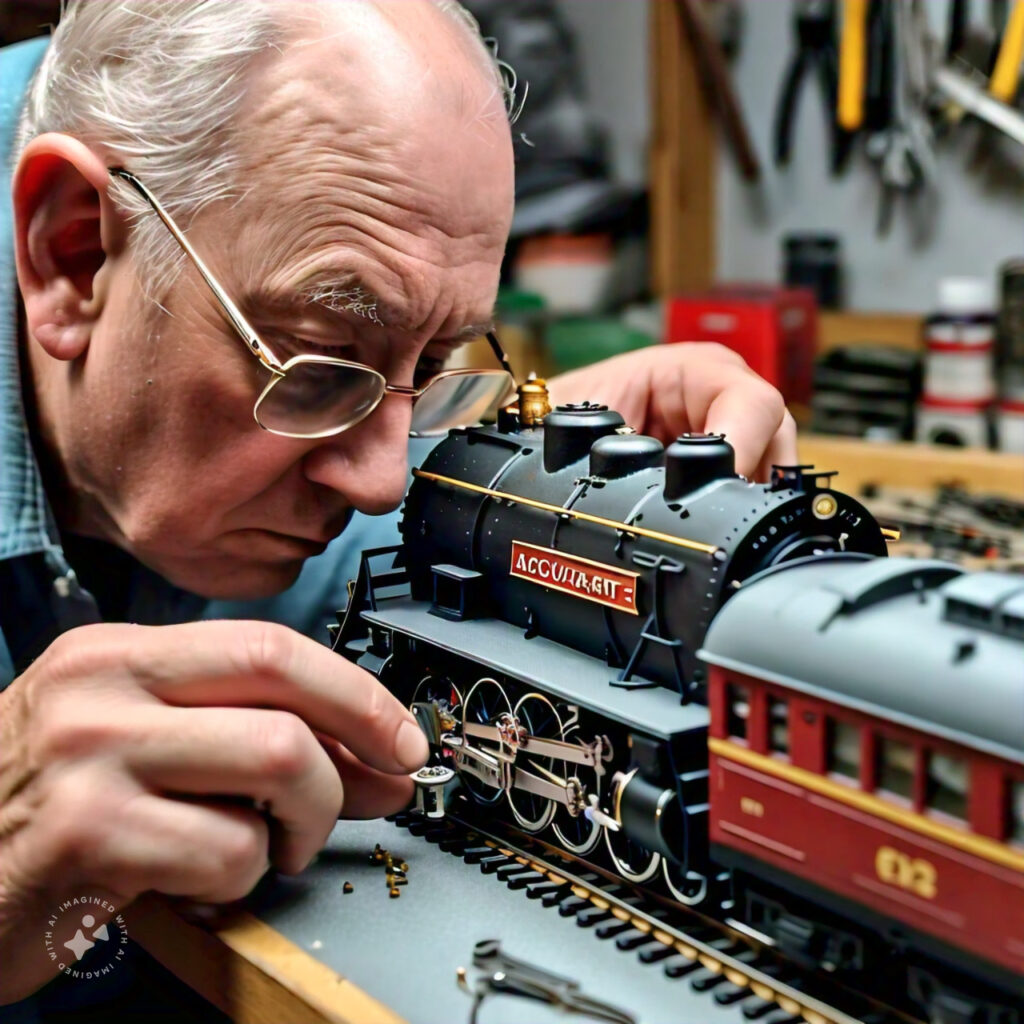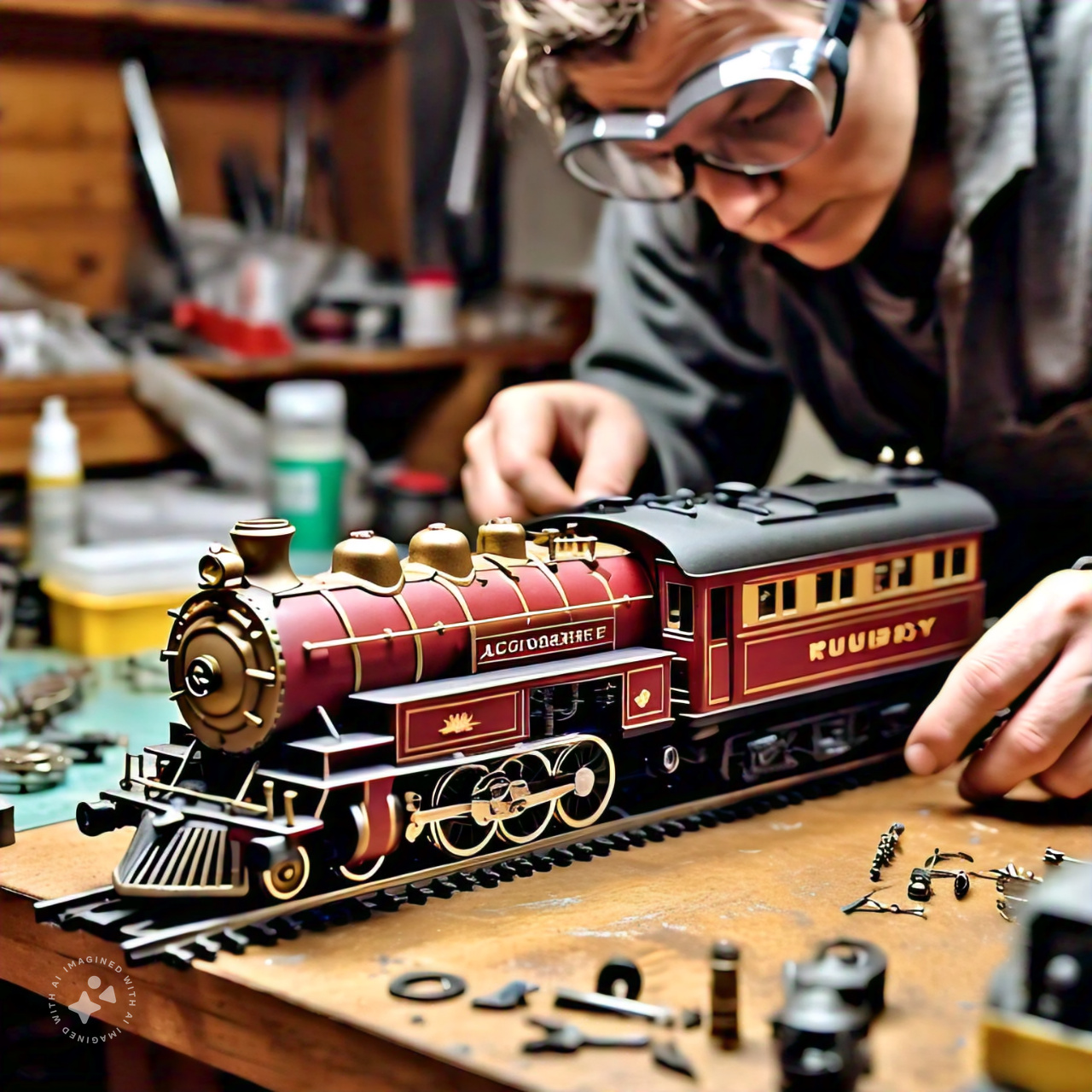The Accucraft Ruby locomotive turns out to be one of the favorites among many model train admirers who are fond of the strength, beauty, and performance that their Accucraft Ruby possesses. Ensuring proper maintenance of your Accucraft Ruby including setting the timing will ensure that your model has a perfect run. Timing actually determines how a steam engine runs. Incorrect timing can end with performance troubles of the model or even damage for much time. Here, we are going to walk you through the process of how to set the timing on an Accucraft Ruby so that it runs properly.
Here, everything from basic elements of the Accucraft Ruby to how to set the timing in very elaborate detail will be broken down in this article. This information will help you clearly understand the process as you either are a beginner or already an experienced hobbyist in making or restoring your railroad model.
Table of Contents
- 1 Understanding Your Accucraft Ruby
- 2 Why Timing is Crucial for the Accucraft Ruby
- 3 How to Set the Timing on an Accucraft Ruby Tools You Need
- 4 How to Set the Timing on an Accucraft Ruby Step-by-Step Guide
- 5 Testing Your Accucraft Ruby After Timing Adjustment
- 6 Tips for Maintaining Your Accucraft Ruby
- 7 Troubleshooting Timing Issues on an Accucraft Ruby
- 8 Conclusion: How to Set the Timing on an Accucraft Ruby
- 9 FAQs: How to Set the Timing on an Accucraft Ruby
Understanding Your Accucraft Ruby
So, it is necessary to know a little about the locomotive before discussing how to set the timing on an Accucraft Ruby . The Accucraft Ruby is a model live steam engine, using a quite simple mechanism of steam to rotate the wheels. Like any steam machine, controlling the entry of steam into the cylinders just at the right time is important in ensuring that pistons push the wheels efficiently.
Key Components of the Accucraft Ruby
To properly set the timing, you need to know the main parts of the Accucraft Ruby that influence the timing mechanism:
- Cylinders: These are where steam enters and pushes the pistons.
- Pistons: The pistons convert steam power into mechanical energy.
- Valve Gear: This controls the timing and movement of the pistons.
- Eccentric Rods: These rods transfer motion to the valves.
- Wheels: Powered by the pistons, they drive the locomotive forward or backward.
Each part of this system must work in perfect harmony for the Accucraft Ruby to operate smoothly.
Why Timing is Crucial for the Accucraft Ruby

The Importance of Setting the Timing
Proper timing ensures that steam enters and exits the cylinders at the correct moments. If the timing is off, the locomotive may not run efficiently. It could experience power loss, hesitation, or even come to a stop unexpectedly. This is why knowing how to set the timing on an Accucraft Ruby is crucial for keeping your model in top condition.
Common Signs of Poor Timing
Here are some indicators that your Accucraft Ruby may have timing issues:
- Lack of power: The locomotive struggles to move or slows down.
- Jerky movements: The locomotive doesn’t run smoothly.
- Excessive steam loss: Too much steam is lost without moving the locomotive forward.
- Strange noises: Clicking or knocking sounds indicate that something is wrong with the valve gear.
By addressing these issues and properly setting the timing, you can enhance the performance of your Accucraft Ruby.
How to Set the Timing on an Accucraft Ruby Tools You Need
Before you begin, gather the tools required to set the timing on your Accucraft Ruby. Having the right tools will make the process easier and more efficient. Here’s a list of what you’ll need:
| Tool | Purpose |
| Small Screwdriver | For loosening and tightening screws on the valve gear. |
| Hex Wrenches | To adjust various components of the locomotive. |
| Timing Jig (Optional) | Assists in ensuring the timing is set accurately. |
| Oil and Lubricants | To lubricate moving parts during and after adjustments. |
| Reference Guide | A detailed schematic of the Accucraft Ruby valve system. |
These tools will help you work on the locomotive without damaging any parts, ensuring that the timing is set correctly.
How to Set the Timing on an Accucraft Ruby Step-by-Step Guide

Now that you understand the components and have the right tools, it’s time to set the timing on your Accucraft Ruby. Follow these simple steps:
Step 1 – Preparing the Locomotive
Start by placing your Accucraft Ruby on a clean, flat surface. Make sure the engine is completely cool and that no steam is present. This ensures your safety and prevents damage to the locomotive.
- Remove the body: Carefully remove the outer casing of the Accucraft Ruby to expose the valve gear and cylinders.
- Lubricate the moving parts: Apply a small amount of oil to the pistons, valve gear, and wheels. This will reduce friction when you begin adjusting the timing.
Step 2 – Locating the Timing Mechanism
The timing on your Accucraft Ruby is controlled by the valve gear and eccentric rods. These parts work together to open and close the steam valves at the right moment. Locate these components before you begin making adjustments.
Step 3 – Adjusting the Eccentric Rods
The eccentric rods play a key role in setting the timing. Here’s how to adjust them:
- Loosen the screws: Use your small screwdriver to loosen the screws that hold the eccentric rods in place.
- Align the rods: Turn the wheels by hand and watch how the rods move. You want to ensure the rods open and close the steam valves just as the pistons reach the end of their stroke.
- Tighten the screws: Once the rods are aligned correctly, tighten the screws back into place.
Step 4 – Fine-Tuning the Valve Gear
Next, adjust the valve gear to ensure the steam enters the cylinders at the proper time:
- Turn the wheels: Rotate the wheels by hand and observe the movement of the valve gear.
- Make small adjustments: If the valves are opening too early or too late, use your hex wrench to adjust the gear slightly. Repeat this process until the valves open exactly when the pistons reach their limit.
- Test the movement: After each adjustment, manually rotate the wheels to ensure smooth operation. The locomotive should move without resistance.
Step 5 – Reassemble the Locomotive
Once the timing is set, reassemble the body of your Accucraft Ruby. Be sure to reattach any parts you removed during the process. After reassembly, test the locomotive by running it on a track with a low amount of steam pressure to see if it moves smoothly.
Testing Your Accucraft Ruby After Timing Adjustment
Run a Test on Low Steam Pressure
After you’ve successfully reassembled your Accucraft Ruby, it’s time to test the locomotive. Light the burner and allow the engine to reach a low steam pressure. Place the locomotive on the track and observe its movement.
- Smooth operation: If the locomotive runs smoothly without hesitation, the timing is correctly set.
- Jerky movements: If the locomotive still exhibits jerky movements, you may need to revisit the valve gear and eccentric rod adjustments.
Final Adjustments
If necessary, perform minor tweaks to the timing mechanism. The goal is to have the Accucraft Ruby run consistently with minimal steam loss.
Tips for Maintaining Your Accucraft Ruby

Regular Lubrication
Regular maintenance is essential for the longevity of your Accucraft Ruby. Keep the moving parts lubricated to reduce friction and wear. Proper lubrication also prevents rust and helps the locomotive run more efficiently.
Keep an Eye on the Timing
Even after successfully setting the timing, it’s a good idea to check it periodically. Over time, vibrations and wear can cause the timing to slip slightly. Regularly checking the valve gear and eccentric rods can prevent performance issues from developing.
Troubleshooting Timing Issues on an Accucraft Ruby
Even with careful adjustment, you may encounter issues with your Accucraft Ruby. Here are some common problems and how to solve them:
| Problem | Solution |
| Locomotive runs slowly | Check if the valves are opening too late. Adjust the valve gear. |
| Jerky movement | Ensure the eccentric rods are properly aligned. |
| Excess steam loss | Inspect for leaks around the cylinders and valve gear. |
| Strange noises | Tighten any loose parts and check for misaligned components. |
Regular maintenance and prompt troubleshooting will keep your Accucraft Ruby in peak condition for years to come.
Conclusion: How to Set the Timing on an Accucraft Ruby
Learning how to set the timing on an Accucraft Ruby is a valuable skill for any model train enthusiast. By following the steps in this guide, you’ll be able to keep your locomotive running smoothly and efficiently. Proper timing ensures that your Accucraft Ruby delivers the performance and reliability you expect from this high-quality steam engine. With regular maintenance, lubrication, and periodic checks, your Accucraft Ruby will continue to be a joy to operate for years to come.
FAQs: How to Set the Timing on an Accucraft Ruby
Q1: Why is setting the timing on my Accucraft Ruby important?
A1: Setting the timing on your Accucraft Ruby ensures that the steam enters and exits the cylinders at the right moment. This directly affects how smoothly and efficiently your locomotive runs. Poor timing can lead to performance issues, such as jerky movements, loss of power, and even damage to the locomotive over time.
Q2: How do I know if the timing on my Accucraft Ruby is off?
A2: Some common signs that the timing is off include the locomotive struggling to move, jerky or erratic movement, excessive steam loss, and unusual noises coming from the engine. If you notice any of these symptoms, it’s time to check and adjust the timing.
Q3: What tools do I need to set the timing on an Accucraft Ruby?
A3: The basic tools you’ll need include a small screwdriver, hex wrenches, oil or lubricants, and a reference guide to the Accucraft Ruby’s valve system. You can also use a timing jig to help ensure accuracy when setting the timing.
Q4: How often should I check the timing on my Accucraft Ruby?
A4: It’s a good idea to check the timing regularly, especially if you notice performance issues. You should also inspect the timing after extended use or if the locomotive has experienced a lot of vibration. Regular maintenance, including timing checks, will help keep your Accucraft Ruby running smoothly.
Q5: Can I adjust the timing myself, or do I need professional help?
A5: While it may seem complex at first, setting the timing on your Accucraft Ruby is something you can do yourself with the right tools and a bit of patience. This guide provides a step-by-step process that even beginners can follow. However, if you’re unsure or uncomfortable with making these adjustments, seeking professional help is always a good option.
Q6: What happens if the timing is set incorrectly?
A6: Incorrect timing can cause several issues, such as poor performance, jerky movement, or even damage to internal components of the locomotive. In some cases, the engine may fail to move at all. It’s important to carefully follow the steps and make precise adjustments to avoid these problems.
Q7: What other maintenance should I perform on my Accucraft Ruby besides setting the timing?
A7: Regular lubrication of moving parts is critical for maintaining your Accucraft Ruby. You should also inspect the engine for any loose screws, leaks, or worn-out parts and replace them as needed. Routine cleaning and checks will ensure long-lasting performance.
Q8: Can setting the timing on an Accucraft Ruby improve its power and speed?
A8: Yes, correctly setting the timing can optimize the power and speed of your Accucraft Ruby. Proper timing allows the steam to work more efficiently, which results in smoother movement, better speed control, and less steam wastage.
Q9: What if my Accucraft Ruby is still running poorly after adjusting the timing?
A9: If the locomotive continues to perform poorly after adjusting the timing, there may be other issues at play, such as worn-out components, steam leaks, or improper lubrication. Double-check all other parts of the engine to ensure everything is in working order.
Q10: How long does it take to set the timing on an Accucraft Ruby?
A10: The time it takes to set the timing will vary depending on your experience level and the condition of your Accucraft Ruby. For beginners, it may take an hour or two to complete the process. With practice, the process becomes quicker and easier.

